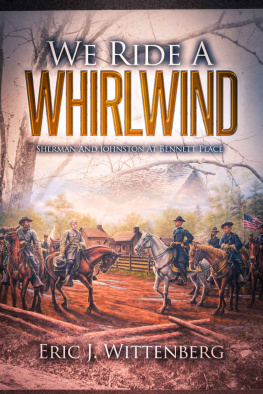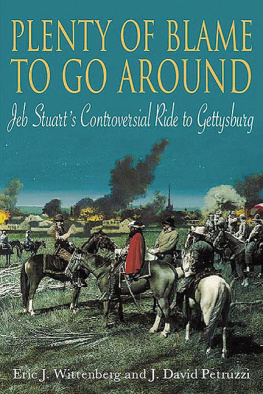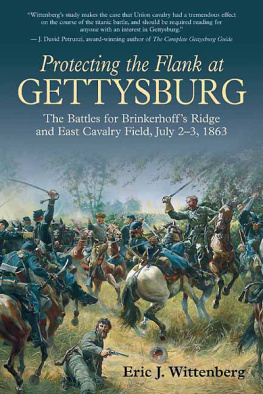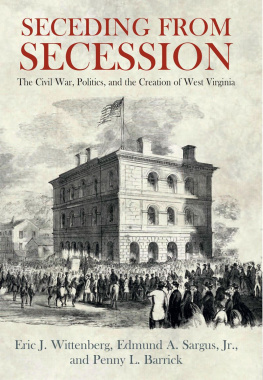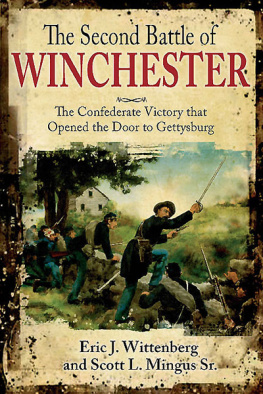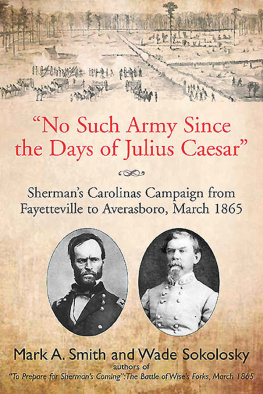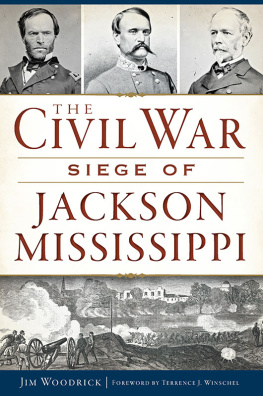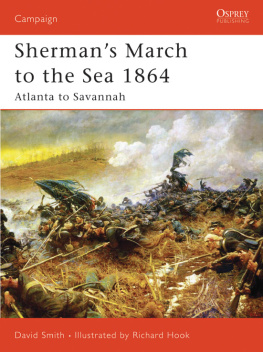Table of Contents
Landmarks
We Ride a Whirlwind:
Sherman and Johnston at Bennett Place
Also by Eric J. Wittenberg
We Have It Damn Hard Out Here": The Civil War Letters of Sergeant Thomas W. Smith, 6th Pennsylvania Cavalry (1999)
One of Custer's Wolverines: The Civil War Letters of Brevet Brigadier General James H. Kidd, 6th Michigan Cavalry (2000)
Under Custer's Command: The Civil War Journal of James Henry Avery (Memories of War) (2000)
At Custer's Side: The Civil War Writings of James Harvey Kidd (2001)
Glory Enough For All: Sheridan's Second Raid and the Battle of Trevilian Station (2001)
With Sheridan in the Final Campaign Against Lee (2002)
Little Phil: A Reassessment of the Civil War Leadership of Gen. Philip H. Sheridan (2002)
The Battle of Monroe's Crossroads and the Civil War's Final Campaign (2006)
Plenty of Blame to Go Around: Jeb Stuart's Controversial Ride to Gettysburg (with J. David Petruzzi, 2006)
Rush's Lancers: The Sixth Pennsylvania Cavalry in the Civil War (2007)
One Continuous Fight: The Retreat from Gettysburg and the Pursuit of Lee's Army of Northern Virginia, July 414, 1863 (with J. David Petruzzi and Michael F. Nugent, 2008)
Like a Meteor Blazing Brightly: The short but controversial life of Colonel Ulric Dahlgren (2009)
The Battle of Brandy Station: North America's Largest Cavalry Battle (2010)
Gettysburg's Forgotten Cavalry Actions: Farnsworth's Charge, South Cavalry Field, and the Battle of Fairfield, July 3, 1863 (Second Edition, 2011)
The Battle of White Sulphur Springs: Averell Fails to Secure West Virginia (2011)
Protecting the Flank at Gettysburg: The Battles for Brinkerhoff's Ridge and East Cavalry Field, July 23, 1863 (Second Edition, 2013)
The Devil's to Pay: John Buford at Gettysburg (2014)
The Second Battle of Winchester: The Confederate Victory that Opened the Door to Gettysburg (with Scott L. Mingus, Sr., 2016)
Out Flew the Sabers: The Battle of Brandy Station, June 9, 1863 (with Daniel T. Davis, 2016)
The Union Cavalry Comes of Age: Hartwood Church to Brandy Station, 1863 (Second Edition, 2017)
We Ride a Whirlwind:
Sherman and Johnston at Bennett Place
Eric J. Wittenberg

2017 by Eric J. Wittenberg. All rights reserved. No part of this publication may be reproduced, stored in a retrieval system, or transmitted, in any form or by any means, electronic, mechanical, photocopying, recording, or otherwise, without the prior writtenpermission of the publisher.
Publishers Cataloging-in-Publication(Provided by Quality Books, Inc.)
Wittenberg, Eric J., 1961- author.
We ride a whirlwind : Sherman and Johnston at Bennett Place / by Eric J. Wittenberg.
pages cm
Includes bibliographical references and index.
LCCN 2017938074
ISBN 978-1-945602-02-3 (hardcover : alk. paper)
ISBN 978-1-945602-03-0 (pbk. : alk. paper)
1. Sherman's March through the Carolinas.
2. United States--History--Civil War, 1861-1865--Peace.
3. Capitulations, Military--Confederate States of America.
4. Capitulations, Military--United States--History--19th century.
5. Sherman, William T. (William Tecumseh), 1820-1891.
6. Johnston, Joseph E. (Joseph Eggleston), 1807-1891.
7. Bennett Place State Historic Site (N.C.)
I. Title.
E477.7.W735 2017 973.7'38 QBI17-704
Cover design by OctagonLab - http://octagonlab.com/
Historical Painting "The First Meeting" by Dan Nance courtesy of the Artist.
www.dannance.com
Photograph: Bennett Place, 1904 courtesy of the Library of Congress
Published by
Fox Run Publishing LLC
2779 South Church Street, #305
Burlington, NC 27215
http://www.foxrunpub.com/
Respectfully dedicated to the memories of two honorable men, Major General William T. Sherman and General Joseph E. Johnston, who had the vision and courage to make peace and to bring an end to four years of horrific civil war.
Maps
----------
ImageList
Images
Author's Preface
I have long been a student of Major General William T. Shermans 1865 Carolinas Campaign, and this is my second book on those events. One cannot study the Carolinas Campaign without also studying the remarkable events that occurred in April 1865 at James T. Bennetts hardscrabble farm near Durham Station in North Carolina. There, in three separate meetings, Sherman and his adversary, Confederate General Joseph E. Johnston, met to discuss not only Johnstons army surrendering, but to end to the Civil War and bring peace to a divided nation. In 1882, Johnston succinctly described their efforts:
I met Gen. Sherman on the 17th of [April] 1865 near Durham, N.C. We made an armistice and agreed upon Terms of Pacification to be suggested to the two governments. They were rejected by Mr. Johnson, President of the U.S. A fact which I was informed by Gen. Sherman on the 24th of the Month. On the 26th we had a second meetingin which Terms of Capitulation were agreed upon, terminating hostilities in our geographical commands, which happened to be coextensive. This as we intended and expected, Terminated the war.
The vision and courage of these two old soldiers spared a lot of unnecessary bloodshed and ended the Civil War, once and for all. This book details the story that Johnston clearly and concisely told in his 1882 letter.
A stark and stunning contrast exists between the historic sites where the two primary surrenders of Confederate forces occurred only a few weeks apart in April 1865. In the years after the war, the War Department purchased the entire village of Appomattox Court House and turned it into a shrine. The village is now part of the National Park Service, with many of the buildings, including Wilmer McLeans handsome home, reconstructed as replicas of the original structures. The Appomattox Court House National Historical Park
- Page ii
consists of 1,800 acres and includes 27 original structures. The park has an ample amount of monuments, and the small battlefield area is well interpreted. General Robert E. Lee briefly fought on the battlefield but aborted the fight upon realizing the Union infantry had arrived, making his plight hopeless. A small military cemetery is located at the site, as well as a large Eastern National Park & Monument Association bookstore and a visitor center with a museum.
In many ways, what happened at Bennett Place is more remarkable, and more important, than what happened at Appomattox Court House. However, the Bennett Place episode has long been downplayed, and even ignored, in light of the more dramatic events at Appomattox. The Bennett Place surrender site is now a North Carolina state park that occupies about four acres, although the state park also consists of a substantial wooded tract located across the road. The original Bennett Place house burned to the ground in 1921, and a replica later replaced it. In 1923, the Unity Monument was erected at the site to pay tribute to the war ending and the nation reuniting. A recently remodeled visitor center includes museum exhibits, a theater, library, and gift shop. The contrast, however, is absolutely shocking when comparing Bennett Place to the plush, huge national park at Appomattox. Bennett Place sits a couple hundred yards from an interstate and is nestled among residential and commercial districts, so the site, realistically, cannot be expanded. Not much else commemorates the location where two of the greatest men of the Civil War era combined efforts to accomplish one of the most astounding events of the American Civil War.

